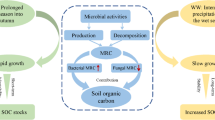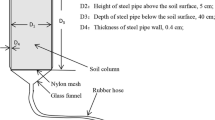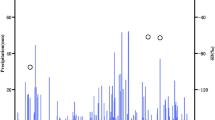Abstract
Purpose
Global climate change scenarios forecast the increasing frequency of extreme precipitation events in the Qinghai-Tibet Plateau (QTP), events that likely will result in increased annual rainfall. The effects of varying rainfall frequency on terrestrial ecosystems, especially in QTP regions impacted by global warming, have become a major research topic. However, the responses of soil labile organic carbon fractions to different rainfall frequencies in the QTP remain unknown.
Methods
In this study, we set five rainfall frequencies in the wet meadows of the QTP (control plots, CK; once a week, DF1; once every 2 weeks, DF2; once every 3 weeks, DF3; and once every 4 weeks, DF4). Rainfall frequency treatments received monthly ambient rainfall plus 25 mm of additional rainfall for each irrigation event, and the number of irrigation events was varied. The soil organic carbon fractions (soil organic carbon, SOC; microbial biomass carbon, MBC; and dissolved organic carbon, DOC) in the 0–10, 10–20, and 20–40 cm soil layers were determined.
Results
We identified significant relationships of soil carbon fractions. With increased rainfall frequency, SOC content increased significantly and DOC content decreased significantly (P < 0.05). The MBC contents of DF3 were 25.1% (0–10 cm) and 32.14% (10–20 cm) higher than that of CK. During the plant growth season, soil carbon components had different patterns over time. The maximum SOC content was recorded in August, and the maximum soil DOC content was recorded in June or July. The minimum content of MBC was observed in July.
Conclusion
Our results show that the low frequency of extreme rainfall events increased microbial activity and promoted the decomposition of SOC, which was not conducive to the accumulation of soil carbon.







Similar content being viewed by others
Data availability
The data sets supporting the results of this article are included within the article and its additional files.
References
Canarini A, Dijkstra FA (2015) Dry-rewetting cycles regulate wheat carbon rhizodeposition, stabilization and nitrogen cycling. Soil Biol Biochem 81:195–203. https://doi.org/10.1016/j.soilbio.2014.11.014
Chan KY, Heenan DP, Oates A (2002) Soil carbon fractions and relationship to soil quality under different tillage and stubble management. Soil till Res 63:133–139. https://doi.org/10.1016/S0167-1987(01)00239-2
Chen X, Chen X, Wang J, Chen B, Wang D, Guan Q (2016) Soil labile organic carbon and carbon-cycle enzyme activities under different thinning intensities in Chinese fir plantations. Appl Soil Ecol 107:162–169. https://doi.org/10.1016/j.apsoi1.2016.05.016
Cheng S, Huang J (2016) Enhanced soil moisture drying in transitional regions under a warming climate. J Geophys Res-Atmos 121:2542–2555. https://doi.org/10.1002/2015JD024559
Davidson EA, Janssens IA (2006) Temperature sensitivity of soil carbon decomposition and feedbacks to climate change. Nature 440:165–173. https://doi.org/10.1038/nature04514
Drenovsky RE, Vo D, Graham KJ, Scow KM (2004) Soil water content and organic carbon availability are major determinants of soil microbial community composition. Microb Ecol 48:424–430. https://doi.org/10.1007/s00248-003-1063-2
Edwards KA, McCulloch J, Kershaw GP, Jefferies RL (2006) Soil microbial and nutrient dynamics in a wet Arctic sedge meadow in late winter and early spring. Soil Biol Biochem 38:2843–2851. https://doi.org/10.1016/j.soilbio.2006.04.042
Enriquez AS, Chimner RA, Cremona MV, Diehl P, Bonvissuto GL (2015) Grazing intensity levels influence C reservoirs of wet and mesic meadows along a precipitation gradient in Northern Patagonia. Wetl Ecol Manag 23:439–451. https://doi.org/10.1007/s11273-014-9393-z
Fan J, Sun W, Zhao Y, Xue B, Zuo D, Xu Z (2018) Trend analyses of extreme precipitation events in the Yarlung Zangbo River Basin, China using a high-resolution precipitation product. Sustainability-Basel 10:1396. https://doi.org/10.3390/su10051396
Farrell M, Hill PW, Farrar J, Bardgett RD, Jones DL (2011) Seasonal variation in soluble soil carbon and nitrogen across a grassland productivity gradient. Soil Biol Biochem 43:835–844. https://doi.org/10.1016/j.soilbio.2010.12.022
Goddard PB, Yin J, Griffies SM, Zhang S (2015) An extreme event of sea-level rise along the Northeast coast of North America in 2009–2010. Nat Commun 6:1–9. https://doi.org/10.1038/ncomms7346
Guo J, Wang B, Wang G, Wu Y, Cao F (2018) Vertical and seasonal variations of soil carbon pools in ginkgo agroforestry systems in eastern China. CATENA 171:450–459. https://doi.org/10.1016/j.catena.2018.07.032
Guimarães D, Gonzaga M, Silva T et al (2013) Soil organic matter pools and carbon fractions in soil under different land uses. Soil till Res 126:177–182. https://doi.org/10.1016/j.still.2012.07.010
Gregorich EG, Beare MH, Mckim UF, Skjemstad JO (2006) Chemical and biological characteristics of physically uncomplexed organic matter Soil. Soil Sci Soc Am J 70:975–985. https://doi.org/10.2136/sssaj2005.0116
Hu Y, Jiang S, Yuan S, Deng L, Xiao H, Shu X, Xia J (2017) Changes in soil organic carbon and its active fractions in different desertification stages of alpine-cold grassland in the eastern Qinghai-Tibet Plateau. Environ Earth Sci 76:348. https://doi.org/10.1007/s12665-017-6684-8
IPCC (2013) Climate Change: The Physical Science Basis
Kalbitz K, Schwesig D, Schmerwitz J, Kaiser K, Haumaier L, Glaser B, Leinweber P (2003) Changes in properties of soil-derived dissolved organic matter induced by biodegradation. Soil Biol Biochem 35:1129–1142. https://doi.org/10.1016/S0038-0717(03)00165-2
Lesk C, Rowhani P, Ramankutty N (2016) Influence of extreme weather disasters on global crop production. Nature 529:84–87. https://doi.org/10.1038/nature16467
Li H, Li T, Sun W et al (2021) Degradation of wetlands on the Qinghai-Tibetan Plateau causing a loss in soil organic carbon in 1966–2016. Plant Soil 467:1–2. https://doi.org/10.1007/s11104-021-05086-6
Li L, Yang S, Wang Z, Zhu X, Tang H (2018) Evidence of warming and wetting climate over the Qinghai-Tibet Plateau. Arct Antarct Alp Res 42:449–457. https://doi.org/10.1657/1938-4246-42.4.449
Liu D, Keiblinger KM, Leitner S, Wegner U, Zimmermann M, Fuchs S, Zechmeister BS (2019) Response of microbial communities and their metabolic functions to drying-rewetting stress in a temperate forest soil. Microorganisms 7:129. https://doi.org/10.3390/microorganisms7050129
Liu T, Wang L, Feng X, Zhang J, Ma T, Wang X, Liu Z (2018) Comparing soil carbon loss through respiration and leaching under extreme precipitation events in arid and semiarid grasslands. Biogeosciences 15:1627–1641. https://doi.org/10.5194/bg-15-1627-2018
Liu X, Li L (2020) Changes in soil carbon and nitrogen stocks following degradation of alpine grasslands on the Qinghai-Tibetan Plateau: a meta-analysis. Land Degrad Dev 32. https://doi.org/10.1002/ldr.3796
Liu E, Chen B, Yan C, Zhang Y, Mei X, Wang J (2015) Seasonal changes and vertical distributions of soil organic carbon pools under conventional and no-till practices on loess plateau in China. Soil Sci Soc Am J 79:517–526. https://doi.org/10.2136/sssaj2014.02.0069
Liu Y, Liu S, Wang J et al (2014) Variation in soil respiration under the tree canopy in a temperate mixed forest, central China, under different soil water conditions. Ecol Res 29:133–142. https://doi.org/10.1007/s11284-013-1110-5
Lourdes M, Jorge D, Alexra R et al (2015) Nitrogen supply modulates the effect of changes in drying-rewetting frequency on soil C and N cycling and greenhouse gas exchange. Global Change Biol 21:3854–3863. https://doi.org/10.1111/gcb.12956
Lu Y, Si B, Li H, Biswas A (2019) Elucidating controls of the variability of deep soil bulk density. Geoderma 348:146–157. https://doi.org/10.1016/j.geoderma.2019.04.033
Luan J, Cui L, Xiang C, Wu J, Song H, Ma Q, Hu Z (2014) Different grazing removal exclosures effects on soil C stocks among alpine ecosystems in east Qinghai-Tibet Plateau. Ecol Eng 64:262–268. https://doi.org/10.1016/j.ecoleng.2013.12.057
Ma W, Li G, Wu J, Xu G, Wu J (2020) Response of soil labile organic carbon fractions and carbon-cycle enzyme activities to vegetation degradation in a wet meadow on the Qinghai-Tibet Plateau. Geoderma 377:114565. https://doi.org/10.1016/j.geoderma.2020.114565
McLatchey GP, Reddy KR (1998) Regulation of organic matter decomposition and nutrient release in a wetland soil. J Environ Qual 27:1268–1274. https://doi.org/10.2134/jeq1998.00472425002700050036x
Miura M, Jones TG, Hill PW, Jones DL (2019) Freeze-thaw and dry-wet events reduce microbial extracellular enzyme activity, but not organic matter turnover in an agricultural grassland soil. Appl Soil Ecol 144:196–199. https://doi.org/10.1016/j.apsoil.2019.08.002
Morillas L, Roales J, Portillo-Estrada M, Gallardo A (2017) Wetting-drying cycles influence on soil respiration in two Mediterranean ecosystems. Eur J Soil Biol 82:10–16. https://doi.org/10.1016/j.ejsobi.2017.07.002
Moyano FE, Manzoni S, Chenu C (2013) Responses of soil heterotrophic respiration to moisture availability. An exploration of processes and models. Soil Biol Biochem 59:72–85. https://doi.org/10.1016/j.soilbio.2013.01.002
Muhr J, Franke J, Borken W (2010) Drying–rewetting events reduce C and N losses from a Norway spruce forest floor. Soil Biol Biochem 42:1303–1312. https://doi.org/10.1016/j.soilbio.2010.03.024
Najera F, Dippold MA, Boy J, Seguel O, Koester M, Stock S, Matus F (2020) Effects of drying/rewetting on soil aggregate dynamics and implications for organic matter turnover. Biol Fert Soils 56:893–905. https://doi.org/10.1007/s00374-020-01469-6
Nelson DW (1982) Total carbon, organic carbon and organic matter. Methods of Soil Analysis 9:961–1010. https://doi.org/10.2136/sssabookser5.3.c34
Pastor J, Post WM (1986) Influence of climate, soil moisture, and succession on forest carbon and nitrogen cycles. Biogeochemistry 2:3–27. https://doi.org/10.1007/BF02186962
Peng F, Xue X, You Q, Huang C, Dong S, Liao J, Wang T (2018) Changes of soil properties regulate the soil organic carbon loss with grassland degradation on the Qinghai-Tibet Plateau. Ecol Indic 93:572–580. https://doi.org/10.1016/j.ecolind.2018.05.047
Pezzolla D, Cardenas LM, Mian IA, Carswell A, Donovan N, Dhanoa MS, Blackwell MSA (2019) Responses of carbon, nitrogen and phosphorus to two consecutive drying-rewetting cycles in soils. J Soil Sci Plant Nut 182:217–228. https://doi.org/10.1002/jpln.201800082
Poret-Peterson AT, Ji B, Engelhaupt E, Gulledge J (2007) Soil microbial biomass along a hydrologic gradient in a subsiding coastal bottomland forest: implications for future subsidence and sea-level rise. Soil Biol Biochem 39:641–645. https://doi.org/10.1016/j.soilbio.2006.09.016
Pu Y, Ye C, Zhang S, Wang G, Hu S, Xu X, Jia Y (2020) Response of the organic carbon fractions and stability of soil to alpine marsh degradation in Zoige, East Qinghai-Tibet Plateau. J Soil Sci Plant Nut 20:2145–2155. https://doi.org/10.1007/s42729-020-00282-2
Qualls RG (2000) Comparison of the behavior of soluble organic and inorganic nutrients in forest soils. Forest Ecol Manag 138:29–50. https://doi.org/10.1016/S0378-1127(00)00410-2
Rui Y, Wang S, Xu Z, Wang Y, Chen C, Zhou X, Luo C (2011) Warming and grazing affect soil labile carbon and nitrogen pools differently in an alpine meadow of the Qinghai-Tibet Plateau in China. J Soil Sediment 11:903. https://doi.org/10.1007/s11368-011-0388-6
Schiedung H, Bornemann L, Gerhard WELP (2017) Seasonal variability of soil organic carbon fractions under arable land. Pedosphere 27:380–386. https://doi.org/10.1016/S1002-0160(17)60326-6
Schwalm CR, Williams CA, Schaefer K et al (2010) Assimilation exceeds respiration sensitivity to drought: a FLUXNET synthesis. Global Change Biol 16:657–670. https://doi.org/10.1111/j.1365-2486.2009.01991.x
Seastedt TR (1984) The role of microarthropods in decomposition and mineralization processes. Annu Rev Entomol 29:25–46. https://doi.org/10.1146/annurev.en.29.010184.000325
Seneviratne SI, Corti T, Davin EL, Hirschi M, Jaeger EB, Lehner I, Orlowsky B, Teuling AJ (2010) Investigating soil moisture-climate interactions in a changing climate: a review. Earth-Sci Rev 99:125–161. https://doi.org/10.1016/j.earscirev.2010.02.004
Soucémarianadin LN, Cécillon L, Guenet B, Chenu C, Baudin F, Nicolas M, Barré P (2018) Environmental factors controlling soil organic carbon stability in French forest soils. Plant Soil 426:267–286. https://doi.org/10.1007/s11104-018-3613-x
Spohn M, Babka B, Giani L (2013) Changes in soil organic matter quality during sea-influenced marsh soil development at the North Sea coast. CATENA 107:110–117. https://doi.org/10.1016/j.catena2.006
Van GM, Merckx R, Vlassak K (1993) Microbial biomass and activity in soils with fluctuating water contents. Geoderma 56:617–626. https://doi.org/10.1016/0016-7061(93)90140-G
Vance ED, Brookes PC, Jenkinson DS (1987) An extraction method for measuring soil microbial biomass C. Soil Biol Biochem 19:703–707. https://doi.org/10.1016/0038-0717(87)90052-6
Wang Y, Wang ZL, Wang H, Guo C, Bao W (2012) Rainfall pulse primarily drives litterfall respiration and its contribution to soil respiration in a young exotic pine plantation in subtropical China. Can J Forest Res 42:657–666. https://doi.org/10.1139/x2012-017
Wang Z, Zhang Z, Yang Y et al (2016) Quantitative assess the driving forces on the grassland degradation in the Qinghai-Tibet Plateau, in China. Ecol Inform 33:32–44. https://doi.org/10.1016/j.ecoinf.2016.03.006
Wu J, Ma W, Li G, Alhassan AR, Wang H, Chen G (2020) Vegetation degradation along water gradient leads to soil active organic carbon loss in Gahai wetland. Ecol Eng 145:105666. https://doi.org/10.1016/j.ecoleng.2019.105666
Wu J, Wang H, Li G, Wu J, Ma W (2021) Vertical and seasonal changes in soil carbon pools to vegetation degradation in a wet meadow on the Qinghai-Tibet Plateau. Sci Rep-UK 11:1–16. https://doi.org/10.1038/s41598-021-90543-6
Wu J (2012) Response of peatland development and carbon cycling to climate change: a dynamic system modeling approach. Environ Earth Sci 65:141–151. https://doi.org/10.1007/s12665-011-1073-1
Xiang SR, Doyle A, Holden PA et al (2008) Drying and rewetting effects on C and N mineralization and microbial activity in surface and subsurface California grasslandsoils. Soil Biol Biochem 40:2281–2289. https://doi.org/10.1016/j.soilbio.2008.05.004
Yan N, Marschner P, Cao W, Zuo C, Qin W (2015) Influence of salinity and water content on soil microorganisms. Int Soil Water Conse 3:316–323. https://doi.org/10.1016/j.iswcr.2015.11.003
Yang X, Meng J, Lan Y, Chen W, Yang T, Yuan J, Han J (2017) Effects of maize stover and its biochar on soil CO2 emissions and labile organic carbon fractions in Northeast China. Agr Ecosyst Environ 240:24–31. https://doi.org/10.1016/j.agee.2017.02.001
Yoon TK, Noh NJ, Han S, Lee J, Son Y (2014) Soil moisture effects on leaf litter decomposition and soil carbon dioxide efflux in wetland and upland forests. Soil Sci Soc Am J 78:1804–1816. https://doi.org/10.2136/sssaj2014.03.0094
Zhang S, Yu Z, Lin J, Zhu B (2020) Responses of soil carbon decomposition to drying-rewetting cycles: a meta-analysis. Geoderma 361:114069. https://doi.org/10.1016/j.geoderma.2019.114069
Zhao J, Thomas E, Yao Y, DeAraujo J, Huang Y (2018a) Major increase in winter and spring precipitation during the Little Ice Age in the westerly dominated northern Qinghai-Tibetan Plateau. Quaternary Sci Rev 199:30–40. https://doi.org/10.1016/j.quascirev.2018.09.022
Zhao Q, Shen W, Chen Q, Helmisaari HS, Sun Q, Jian S (2018b) Spring drying and intensified summer rainfall affected soil microbial community composition but not enzyme activity in a subtropical forest. Appl Soil Eco 130:219–225. https://doi.org/10.1016/j.apsoil.2018.06.014
Zhu B, Cheng W (2013) Impacts of drying-wetting cycles on rhizosphere respiration and soil organic matter decomposition. Soil Biol Biochem 63:89–96. https://doi.org/10.1016/j.soilbio.2013.03.027
Acknowledgements
We thank the Fostering Foundation for the Excellent Ph.D. Dissertation of Gansu Agricultural University, China (YB2018004), and “Innovation Star” Project for Excellent Postgraduates of Gansu Province, China (2021CXZX-364), Collaborative Innovation Team Project of Higher Education Institutions in Gansu Province, China (2018C-16), Primary Research and Development Plan of Gansu Province, China (18YF1NA070), and Special Financial Gansu Province, China (GSCZZ-20160909).
Author information
Authors and Affiliations
Contributions
JQW and GL designed the experiment, HYW and JQW conducted experiments and collected data, JQW and XXW analyzed the data. HYW, JQW, GL, and LJY wrote the manuscript. All authors approved the final manuscript.
Corresponding author
Ethics declarations
Ethics approval
Not applicable.
Consent to participate
Written informed consent to participate was obtained from all participants.
Consent for publication
Written informed consent for publication was obtained from all participants.
Conflict of interest
The authors declare no competing interests.
Additional information
Responsible editor: Yan He
Publisher's Note
Springer Nature remains neutral with regard to jurisdictional claims in published maps and institutional affiliations.
Supplementary information
Below is the link to the electronic supplementary material.
Rights and permissions
About this article
Cite this article
Wang, H., Wu, J., Li, G. et al. Effects of rainfall frequency on soil labile carbon fractions in a wet meadow on the Qinghai-Tibet Plateau. J Soils Sediments 22, 1489–1499 (2022). https://doi.org/10.1007/s11368-022-03170-7
Received:
Accepted:
Published:
Issue Date:
DOI: https://doi.org/10.1007/s11368-022-03170-7




